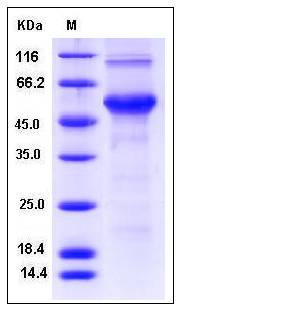Human DMP1 Protein (His Tag)
ARHP,ARHR,DMP-1
- 100ug (NPP3808) Please inquiry
| Catalog Number | P11929-H08H |
|---|---|
| Organism Species | Human |
| Host | Human Cells |
| Synonyms | ARHP,ARHR,DMP-1 |
| Molecular Weight | The recombinant human DMP1 consists of 508 amino acids and predictes a molecular mass of 55.4 kDa. In SDS-PAGE under reducing conditions, the apparent molecular mass of rhDMP1 is approximately 53 kDa. |
| predicted N | Leu 17 |
| SDS-PAGE |  |
| Purity | > 85 % as determined by SDS-PAGE |
| Protein Construction | A DNA sequence encoding the human DMP1 (Q13316-1) (Met 1-Tyr 513) was expressed, with a polyhistidine tag at the C-terminus. |
| Bio-activity | Measured by its ability to bind human CFH in a functional ELISA. |
| Research Area | Immunology |Signal Transduction |Cytoskeleton / ECM |Extracellular Matrix |Structures |Bone | |
| Formulation | Lyophilized from sterile PBS, pH 7.4 1. Normally 5 % - 8 % trehalose and mannitol are added as protectants before lyophilization. Specific concentrations are included in the hardcopy of COA. |
| Background | Dentin matrix acidic phosphoprotein (DMP1) is an extracellular matrix protein and a member of the small integrin binding ligand N-linked glycoprotein family. This protein, which is critical for proper mineralization of bone and dentin, is present in diverse cells of bone and tooth tissues. DMP1 contains a large number of acidic domains, multiple phosphorylation sites, a functional arg-gly-asp cell attachment sequence, and a DNA binding domain. In undifferentiated osteoblasts it is primarily a nuclear protein that regulates the expression of osteoblast-specific genes. During osteoblast maturation, DMP1 becomes phosphorylated and is exported to the extracellular matrix, where it orchestrates mineralized matrix formation. Mutations in DMP1 are known to cause autosomal recessive hypophosphatemia, a disease that manifests as rickets and osteomalacia. DMP1 may have a dual function during osteoblast differentiation. In the nucleus of undifferentiated osteoblasts, unphosphorylated form acts as a transcriptional component for activation of osteoblast-specific genes like osteocalcin. During the osteoblast to osteocyte transition phase it is phosphorylated and exported into the extracellular matrix, where it regulates nucleation of hydroxyapatite. |
| Reference |
